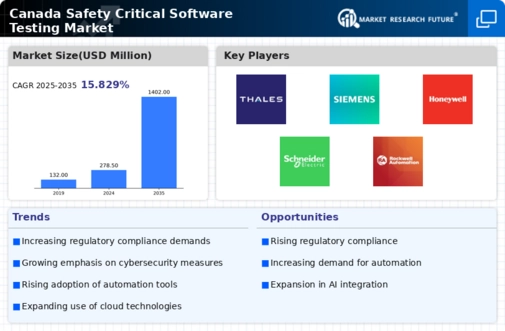Growing Investment in R&D
Investment in research and development (R&D) within the safety critical-software-testing market is on the rise, driven by the need for innovative solutions to complex safety challenges. Canadian companies are allocating substantial budgets to R&D, with estimates suggesting an increase of 20% in funding over the next five years. This investment is aimed at developing new testing frameworks and tools that can address emerging safety concerns in various industries. As organizations strive to enhance their testing capabilities, the focus on R&D is likely to yield advanced methodologies that improve software reliability and safety, thereby expanding the market's potential.
Increasing Regulatory Demands
The safety critical-software-testing market is experiencing heightened regulatory demands, particularly in sectors such as aerospace, automotive, and healthcare. Regulatory bodies in Canada are enforcing stricter compliance standards to ensure software reliability and safety. This trend is evident as organizations are required to adhere to standards like DO-178C for avionics software and ISO 26262 for automotive systems. As a result, companies are investing more in safety critical software testing to meet these regulations, which is projected to drive market growth by approximately 15% annually. The emphasis on compliance not only enhances product safety but also fosters consumer trust, thereby propelling the demand for rigorous testing methodologies.
Technological Integration in Testing
The integration of advanced technologies into the safety critical-software-testing market is transforming testing methodologies. The adoption of artificial intelligence (AI) and machine learning (ML) is enabling more efficient testing processes, allowing for predictive analytics and automated testing scenarios. In Canada, organizations are increasingly leveraging these technologies to enhance the accuracy and speed of testing, which is crucial in safety-critical environments. This shift is expected to contribute to a market growth rate of around 12% over the next few years. Furthermore, the ability to simulate real-world conditions through virtual environments is becoming a standard practice, thereby improving the overall quality and reliability of safety-critical software.
Shift Towards Agile Development Practices
The safety critical-software-testing market is witnessing a shift towards agile development practices, which emphasize flexibility and rapid iteration. Canadian organizations are increasingly adopting agile methodologies to enhance collaboration between development and testing teams. This approach allows for continuous testing and integration, which is essential in safety-critical environments where timely updates are crucial. The adoption of agile practices is projected to contribute to a market growth rate of around 10% as companies seek to improve their responsiveness to changing requirements. By fostering a culture of collaboration and adaptability, organizations can better ensure the safety and reliability of their software products.
Demand for Enhanced Cybersecurity Measures
The increasing threat of cyberattacks is prompting a significant demand for enhanced cybersecurity measures within the safety critical-software-testing market. In Canada, industries such as finance, healthcare, and transportation are particularly vulnerable, leading to a surge in the need for robust testing protocols that address cybersecurity risks. Organizations are now prioritizing security testing as an integral part of their software development lifecycle. This shift is expected to drive market growth by approximately 18% as companies seek to protect sensitive data and ensure compliance with cybersecurity regulations. The focus on cybersecurity not only safeguards critical systems but also enhances overall software integrity.
















Leave a Comment